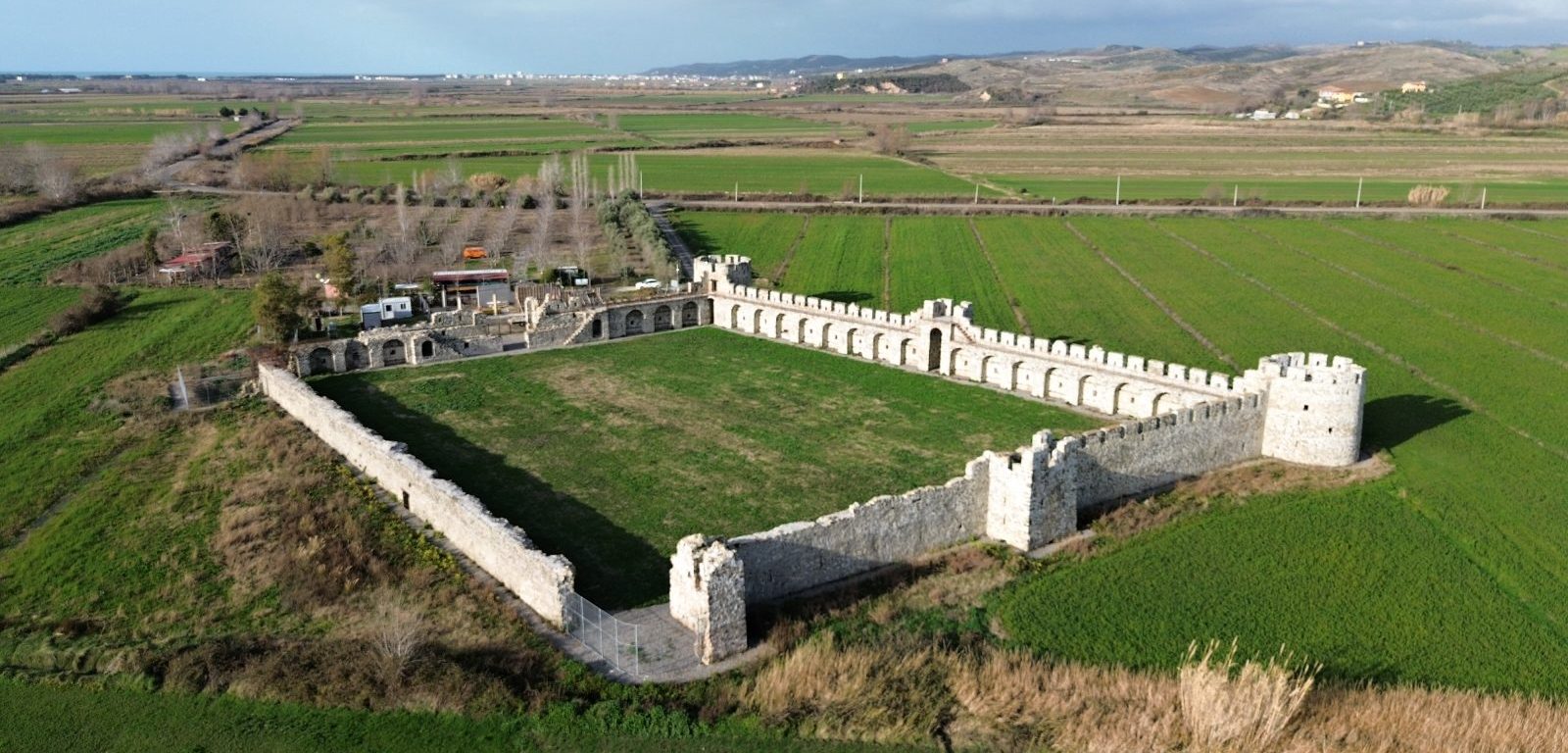On the right side of the main entrance to Bashtova Castle in Rrogozhina, in what was believed to be one of the towers, archaeologists have discovered a water-gate tower, or the castle’s river port, which connected it with the river channel, allowing goods to be transported from the castle to the sea and other ports.
This is one of the main findings of a year-long restoration project supported by EU4Culture. The project, preceded by archaeological excavations and surveys, aimed to better understand the 5,400 m² field castle, built sometime in the 15th century.
“This is very important. Let’s think about how this terrain looked 500 years ago, when it was built. The Shkumbin River is now relatively close, the sea is close, and there is now a field and some forests in between. During the excavations, our archaeologists found that the original flooring of the castle lies 1.7 metres below the current level,” says Lejla Hadzic, Cultural Heritage Advisor at UNOPS Albania, the implementing partner of the EU4Culture programme. “We can now understand that the whole area was almost two metres lower. It means that the river would have come much closer to the castle, which of course explains that the castle was most probably on the river. This definitely strengthens the reasoning for why this field castle was built, most likely to serve as a small defensive outpost where merchants and producers from the area would come to exchange goods,” she explains.
Overseen from the castle’s towers, the entire protected area covers a surface of 646,000 m². Once upon a time, it served merchants coming and going, connecting people, civilisations, and cultures, where grain and textiles were traded. Built by the Venetians and later conquered by the Ottomans, who constructed a mosque and reconstructed a portion on the western side, archaeologists have also discovered, during one of their surveys outside one of the towers, part of a path that could have connected the castle to the Via Egnatia.
“One of the test pits next to the entrance has yielded some very interesting data. The archaeological excavations have revealed that the circular tower had five flooring levels and was once covered with a timber roof. The findings also showed that it was burned down at some stage. Different types of defensive loopholes were identified, and alongside them, we found a significant number of cannonballs, both iron and stone, confirming the defensive function of the tower over a long period of time,” explains Hadzic. The excavations were led by Professor Lorenc Bejko and Professor Iris Pojani. The area is now confirmed to have been connected by land and water routes to both East and West.
Additional important findings were revealed through the work of the Institute of Conservation of the University of Applied Arts in Vienna. Their geologists and stone conservators collected around 15 samples of mortar, brick, and stone to conduct a set of analyses feeding into the conservation design. One of the most interesting results came from a thermoluminescence test conducted on the brick samples.
“Professor Gjerak Karaiskaj has stated that the castle was built between 1467 and 1478. The thermoluminescence test dated the bricks to the early 16th century, while the castle was built in the late 15th century. However, tests on bricks taken from a portion of the wall assumed to have been built later produced different results, dating that section to the mid-18th century, while historical records show that the Ottomans actually rebuilt that portion in the early 16th century. This will require further research and testing in the future,” says Hadzic.
Archaeological excavations were conducted at 11 points across the castle (a total of 15 test pits) prior to conservation work, in order to determine whether cracks at foundation level were still active. These excavations led to the discovery of key findings, the lower original floor, the port, the circular tower, and the Via Egnatia connection, revealing how the fortress sustained the inland area. Referring to the port, Hadzic emphasises that it is “really the most important and first-ever discovery regarding this castle. What the castle needs in the future is definitely larger excavations of the road that was discovered, larger excavations in the circular tower, and probably further excavations in the surrounding field to fully understand the port and the shape of its connecting channel walls.”
The final outcome of the conservation process was that all remaining fortification walls were consolidated and preserved. The techniques and materials applied strictly followed the analyses conducted by the Institute of Conservation in Vienna, using the exact measurements and material ratios tested in the laboratory. To ensure a safe and pleasant experience for visitors, railings on staircases and walkways were installed, along with walking platforms. The project also introduced a new layer of historical interpretation, combining classical information panels in the field with an augmented reality (AR) application featuring 12 interactive spots. Six of these are designed for adult visitors, while the remaining six form a treasure hunt for children, incorporating myths and legends.
“This is the first time that augmented reality has been used in the field of the castle. As you walk through, you can scan the reference points, and the images appear virtually in front of you, there’s nothing like this in Albania until now,” explains Hadzic. Excited about the opportunities this offers for children to explore Bashtova’s heritage, she highlights the importance of creating engaging connections for young people, helping them appreciate and protect this cultural legacy for the future.
According to Hadzic, the studies conducted before the restoration process have created a strong foundation to propose Bashtova Castle for designation as a UNESCO World Heritage Site, as it is already one of Albania’s tentative candidates. Starting from the discovery of its river port, the castle may still hold many more secrets waiting to be uncovered.

